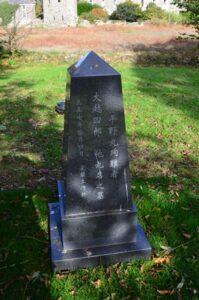The Village of Angle sits in a picturesque location on a narrow peninsula, overlooking the Haven. The village contains an ancient castle, and is a popular tourist area throughout the summer months due to the location of several fine beaches. The men of Angle who served during the Great War is afforded by a granite plaque which is affixed to the Memorial Hall, and lists all of the men who served. The main War Memorial plaque is inside St. Mary’s Church, and is made of marble. Added to the page are men who were either born or resided at Angle, who are not commemorated on either memorial. Many thanks to Les Nixon for the photographs of the Memorial Plaque, and of the burials within Saint Mary’s Churchyard, and thanks to Paul Childs for the photograph of the St, Mary’s Church Memorial.
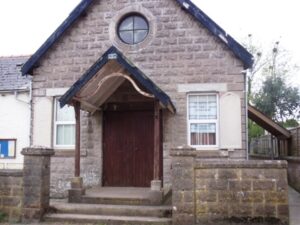
The Great War, 1914-1918
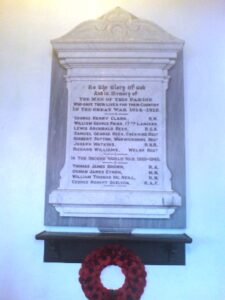
George Henry Clark, Petty Officer Stoker, 168879, Royal Navy. George was born at Liverpool on 24 April 1872, and joined the Royal Navy. He served aboard HMS Goliath, which was a Canopus Class Battleship, which had been commissioned in 1900, for service on the China Station. After three years service in the Far East she returned to Chatham, and by 1913 had been mothballed at Pembroke Dock. During this time, George had married Sarah Maria Jones, from Angle in 1906. Goliath was re-commissioned at the outbreak of war, and saw service in the English Channel and in the East Indies, before moving to the Mediterranean to support the Gallipoli landings. Early in the morning of 13 May 1915, Goliath was torpedoed by the Turkish torpedo boat Muavenet, and rolled over and sank, with the loss of over 570 lives. George was 43 years old when he died that day, and he is commemorated on the Chatham Naval Memorial, Kent.
Thomas Davies, Trimmer, 1809TS, Royal Naval Reserve. Thomas was born at Angle on 28 May 1884, the son of George and Margaret Davies. He served with the Royal Navy prior to the war, prior to returning to civilian life, and was recalled to the Royal Naval Reserve at the outbreak of war. Thomas was posted to the Ramsgate Depot, HMS Ceto. Little else is known of him, but he died in Surrey on 26 February 1915, aged 31, and is buried in Brookwood Military Cemetery, Surrey. His next of kin was shown as his sister, Mrs Elizabeth Brinn, of 38, Plasygamil Road, Goodwick, Pembrokeshire. Thomas does not appear to be commemorated anywhere locally.
Herbert William Howells, Private, 8753, Cheshire Regiment. Herbert was the son of William and Beatrice Bamkin, of Angle. He resided with his uncle John Bamkin at Portsmouth prior to the outbreak of war. He enlisted into the Cheshire Regiment prior to the war, and was posted to their 1st Battalion, which was attached to 15 Brigade, 5th Division. The Division had landed at Havre on 15 August, 1914, and fought at the Battle of Mons, and during the retreat south, fighting at Le Cateau, then down to the Marne where the German attack was halted. They took part in the advance to the Aisne, before moving to Flanders, where they fought at the Battle of La Bassée, then at Messines in October, 1914. They fought here through First Ypres, and took part in the capture of Hill 60, which is probably where Herbert was killed on 13 November 1914. He has no known grave, and is commemorated on the Ypres (Menin Gate) Memorial, Belgium. Herbert is not commemorated on the Angle War Memorial.
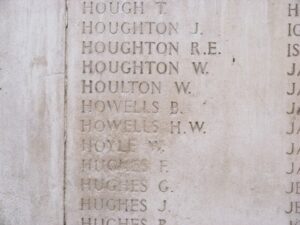
William George Paish, Lance Corporal, 1995, 17th Lancers (Duke Of Cambridges Own). William was born at Trimulgherry, India, the son of Colour Sergeant George Paish, and Annie Paish, of 2, Barton Place, Pembroke. He enlisted at Pembroke into the 17th Lancers, Duke of Cambridge’s Own, which was attached to 7 Cavalry Brigade, 3rd Cavalry Division. The division had been in France since attempting to stem the German advance on Antwerp, and had fought at the Battles of Ypres, Loos and Arras. It took part in the opening of the Battle of Amiens, south of the River Somme, on 8 August 1918, which was the battle which turned the course of the war. William was killed that day, on 8 August 1918, aged 24. He is buried at Manitoba Cemetery, Caix, France.

Thomas Phillips, Private, 139924, Machine Gun Corps. Thomas was the son of Pearce and Mary Phillips, of The Park, St. Twynnells, Pembroke. He enlisted at Pembroke into the Army, and was posted to the Monmouth Regiment, with the service number 229365. After receiving his training, Thomas was posted to the Machine Gun Corps, and joined their 38th Battalion, which was attached to the 38th (Welsh) Division. The Division had been in France since December 1915 and had fought during the Battle of the Somme in 1916 and at Pilckem Ridge in 1917. On 21 March 1918 the Germans launched an offensive on the Somme, and within days had pushed the British back over twenty miles. The 38th Division was sent to the Somme to hold the line north of Albert, and took the line around Aveluy Wood. Thomas was killed in action here during an operation to recapture Bouzincourt Ridge on 24 April 1918. He was 33 years old, and is buried at Bouzincourt Ridge Cemetery, France. Thomas is not commemorated on the Angle War Memorial.
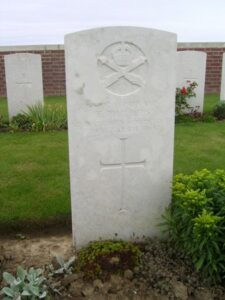
Walter Rutland Rattenbury, Rifleman, S/3415, Rifle Brigade. Walter was born at Angle, the son of Henry and Frances Rattenbury. The family resided at Hove, in Sussex prior to the outbreak of war. Walter enlisted at London on 10 September 1914 into the 12th Battalion, Rifle Brigade, which was attached to 60 Brigade, 20th (Light) Division. On 26 July 1915 the Division completed concentration in the Saint-Omer area, all units having crossed to France during the preceding few days. Early trench familiarisation and training took place in the Fleurbaix area. When the Battle of Loos was launched on 25 September 1915 the Division fought a diversionary attack towards Fromelles. Walter was killed in action here on 25 September 1915, aged 20. He has no known grave, and is commemorated on the Ploegsteert Memorial, Belgium. Walter is not commemorated on the Angle War Memorial.
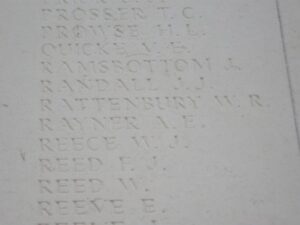
Lewis Archibald Rees, MM, Sergeant, 47957, Royal Garrison Artillery. Lewis was born at Angle, the son of John and Elizabeth Rees. He lived with his brother Howard at Abertillery prior to the war, where the brothers worked as coal miners. Lewis enlisted at Pontypridd on 22 October 1914 into the Royal Garrison Artillery, and on 6 June 1915 was posted to France, joining ‘X’, 50th Trench Mortar Battery. Little is known of Lewis’ war, but he was awarded the Military Medal for Bravery in the Field on the Somme before being seriously wounded by shrapnel on 14 February 1917, during the German withdrawal to the Hindenburg Line. Lewis died of his wounds on 15 February 1917, aged 23. He is buried at Bray Military Cemetery, France.
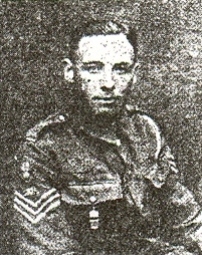
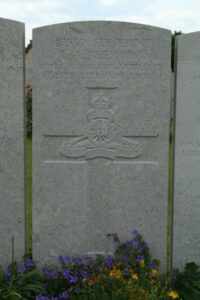
Samuel George Rees, Private, 28765, Herefordshire Regiment. Samuel was born in Angle, the son of John and Elizabeth Rees, of Court House. When war broke out, Samuel was living in Laugharne. He enlisted into the King’s Shropshire Light Infantry. Samuel was then posted to the 1/1st Battalion, Hereford Regiment, with the service number 28765. The 1/1st Herefords were a Territorial Battalion, which formed part of 158 Brigade, 53rd (Welsh) Division. The Battalion embarked at Devonport on the SS Euripides on 16 July 1915. From Devonport they sailed to Port Said, before landing on C Beach, at Suvla Bay, Gallipoli on 9 August 1915. After all the Allied forces had been withdrawn from Gallipoli, the 53rd Division fought in Palestine. After a hard fought campaign, they had the Turks on the run in the Middle East, and with the Allies facing a shortage of men on the Western Front, after the German Offensives began in March 1918 the Battalion left the Division, and arrived in France on 30 June, becoming attached to 102 Brigade, 34th Division. The 34th Division were at this time fighting alongside the French XXX Corps in Champagne, where they took part in the Battle of the Marne, 1918, and the Battle of the Soissonais and the Ourcq. They then moved to Flanders, where they took part in the advance in Flanders, culminating in the Battle of Ypres, 1918, and the Battle of Courtrai. It was during the Battle of Courtrai that Samuel was killed on 16 October 1918, and he was buried where he fell. He now lies in Hooge Crater Cemetery, East of Ypres on the Menin Road.
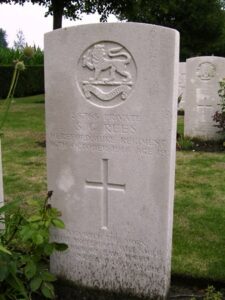
Reginald Emerson Richards, Private, 73662, Welsh Regiment. Reginald was born in Angle in 1899, the son of Reinfred William and Mary Richards, of Bush Farm, Angle. At some time between 1911 and 1914 the family had moved to 25, High Street, Abertridwr, and Reginald enlisted there on 10 September 1915 into the Welsh Regiment, and was posted to France on 13 September 1918, joining the 14th Battalion, Welsh Regiment, which was attached to 114 Brigade, 38th (Welsh) Division. Reginald joined the battalion during its drive across the old Somme battlefields towards the outer Hindenburg Line defences, and he was killed in action during fighting at the Canal du Nord on 8 October 1918, aged 19. He has no known grave and is commemorated on the Vis-En-Artois Memorial, France. Reginald is not commemorated locally.
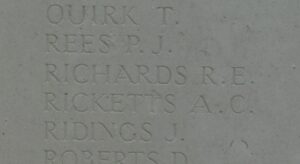
James Thompson Smith, Lance Corporal, 12281, Welsh Regiment. James was born at Angle, the son of John Smith. The family later lived at Hoarstone Cottage, Martletwy, Narberth. James enlisted at Pentre, Glamorgan, into the Welsh Regiment, and was posted to their 8th Battalion, attached to 40 Brigade, 13th (Western) Division. Towards the end of February the entire Division concentrated at Blackdown in Hampshire. On 7 June 1915 orders were received to prepare to move to the Mediterranean. On 13 June 1915 the first transports carrying the Division left port, and moved to Alexandria. By 4 July, all units had moved to Mudros, preparatory for landing on Gallipoli. Between 6 and 16 July 1915 the Divisional infantry landed on Cape Helles and relieved the 29th Division. They left and returned to Mudros at the end of the month, and the entire Division landed at ANZAC Cove between 3 and 5 August, 1915, taking part in the Battles of Sari Bair, Russell’s Top, and Hill 60, ANZAC. Soon afterwards the Division was transferred from ANZAC to Suvla Bay, and it was here that James was wounded. He was evacuated to a Hospital Ship where he died of his wounds on 28 November 1915. James was 27 years old, and was buried at sea, and so is commemorated on the Helles Memorial, Gallipoli. James is not commemorated on the Angle War Memorial.
Herbert Sutton, Private, 22087, Royal Warwickshire Regiment. Herbert was the son of Jessie and Annie Sutton, of 11, Cottage, Angle and 2, Station Road, Pembroke. He enlisted at Pembroke into the 1/4th Welsh, but later transferred into the 1/6th Battalion, Royal Warwickshire Regiment, part of 143 Brigade, 48th Division. The Division moved to France between 22 March and 1 April 1915, and saw its first major engagement at the opening of the Battle of the Somme, holding the line between the 56th (London) and the 31st Divisions, both of which were heavily engaged at Gommecourt and Serre respectively. Two of the battalions of the Division attacked on 1 July 1916, and suffered heavy casualties. They then went into action at the Battle of Bazentin, during the second phase of the Battle of the Somme, and captured Ovillers. They also fought at the Battle of Pozieres and the Battle of the Ancre. In March 1917 they followed the German Retreat to the Hindenburg Line, and it was during this advance that Herbert was killed on 16 April 1917. He was just 19 years old and is commemorated on the Thiepval Memorial, France.
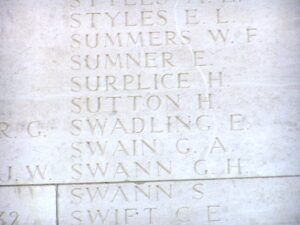
Frederick Thomas, Private, 27342, Welsh Regiment. Frederick was the son of James and Annie Thomas, of Upper Lodge, Castle Hall, Milford Haven. He resided in Angle prior to the war, and enlisted at Pembroke into the 2nd Battalion, Welsh Regiment. The Battalion formed part of 3 Brigade, 1st Division, which had been one of the first to arrive in France, fighting at the Battle of Mons, and taking part in the retreat to the Marne, where the Germans were stopped. They then fought at the Aisne, and at Chivy, before being moved North to Ypres. Here they fought at the First Battle of Ypres, where they again stopped the German Offensive, before wintering in Flanders. The following year saw them in action again at the Battle of Aubers, before moving South to Loos, where they fought during the Battle of Loos, and the action at the Hohenzollern redoubt. Frederick was wounded at Loos that winter, and evacuated to the base hospital at Rouen, where he died of his wounds on 10 March 1916. He was 18 years old, and is buried at St. Sever Cemetery, Rouen, France. Frederick is not commemorated on the Angle War Memorial.

Samson Thomson, Able Seaman, 159877, Royal Navy. Samson was born at Pwllcrochan on 12 January 1875, the son of James and Sarah Thomson, of Bullwell Cottage. He had served in the Royal Navy for many years prior to the war, and by 1914 was serving aboard the Thornycroft type River Class Destroyer HMS Jed. At the outbreak of war Jed was based at Hong Kong, and was deployed to Tsingtao to blockade the German base. She was deployed to the Mediterranean Fleet in November 1914, as part of a fleet which supported the Dardanelles campaign, and on 25 April 1915 supported the landings at ANZAC Cove. Samson was killed on 7 August 1915, aged 40, and was buried at sea. He is commemorated on the Plymouth Naval Memorial, Devon. Samson is not commemorated locally.
Arthur George Ward, Private, 19634, Royal Welsh Fusiliers. Arthur was the son of William Henry and Maria Mary Ward, of 1, Weir Pond Road, Rochford, Essex. He resided at Chapel Bay Fort, near Angle prior to the war, and enlisted at Pembroke into the Army. He was posted to the 8th Battalion, Royal Welsh Fusiliers, which was attached to 40 Brigade, 13th (Western) Division. Towards the end of February the entire Division concentrated at Blackdown in Hampshire, and by August had landed at Gallipoli, where it saw heavy fighting during its time there. On 8 January 1916, the Division was evacuated from Helles, and by 31 January was concentrated at Port Said, where they held forward posts in the Suez Canal defences. On 12 February, 1916 the Division began to move to Mesopotamia, to strengthen the force being assembled for the relief of the besieged garrison at Kut al Amara. By 27 March, the Division had assembled near Sheikh Saad and came under orders of the Tigris Corps, and then took part in the attempts to relieve Kut. Arthur was killed in action here on 9 April 1916. He was 19 years old, and is commemorated on the Basra Memorial, Iraq. Arthur is not commemorated on the Angle War Memorial.
Joseph Watkins, Leading Seaman, 1774C, Royal Naval Reserve. Joseph was born on 17 September 1880, the son of James and Margaret Watkins, of Angle. He married Alice Evans in 1906, and the couple lived at 17, Angle, where their two children were born. Joseph served in the Royal Naval Volunteer Reserve, aboard HMS Champagne. She had been taken over by the Admiralty for service as an auxiliary cruiser, as part of the 10th Cruiser Squadron, and sunk a German submarine in March 1915 whilst patrolling between Scotland and Norway off the Skerryvore Lighthouse. In 1917 she was lent to the French navy and was renamed the Champagne, but retained her British crew, and on 9 October 1917 she was torpedoed and sunk by a German submarine whilst in the Irish Sea with the loss of 5 officers and 51 men. Joseph was one of the men lost aboard Champagne that day. He was 38 years old, and is commemorated on the Plymouth Naval Memorial, Devon. Joseph had been awarded the Russian Medal for Zeal for his part in the sinking of the German submarine in 1915.
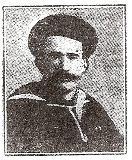
Richard Williams, Lance Sergeant, 29094, Welsh Regiment. Richard was born at Angle, and had married prior to the outbreak of war, living with his wife Harriet Ann Williams at Swansea. He enlisted there into the 14th Battalion, Welsh Regiment, which was known as the ‘Swansea Pals’, and formed part of 114 Brigade, 38th (Welsh) Division. After training at Rhyl and Winchester, the Battalion moved to France in December 1915 and took the line near Fleurbaix. The 38th Division trained here over the winter of 1915/16, before being moved south in June 1916, where they took part in the Somme Offensive, during the attack on Mametz Wood. The fighting for the wood cost the Welsh Division many casualties, among them was Richard, who was killed on 12 July 1916, the day the Division was pulled out of the wood. Richard has no known grave, and is commemorated on the Thiepval Memorial, France. He was 27 years old.
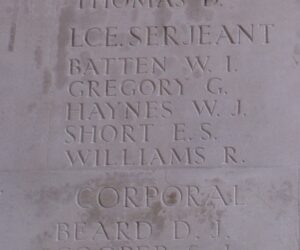
World War Two, 1939-1945
Thomas James Brown, Gunner, 872327, Royal Artillery. Thomas was the son of James and Florence C. Brown, of Angle, and served with 9 Coast Regiment, Royal Artillery. The regiment formed part of the Singapore Fortress Defences at the outbreak of war, and saw heavy fighting during the Japanese invasion of the Island in December 1942. Thomas was taken prisoner when Singapore was surrendered to the Japanese on 15 February 1942. He died the following day, on 16 February 1942 in captivity. Thomas was 29 years old, and is commemorated on the Singapore Memorial, Singapore.
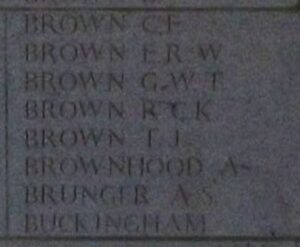
Osman James Angle Eynon, Coxswain, Merchant Navy. Osman was the son of Thomas and Mary Eynon. He married Florence E. Watkins, of Angle on 21 June 1919. He served as Coxswain aboard the MV Lady Drusie. Little is known of the Lady Drusie, but it was lost on 3 November 1940. Osman’s body must have washed ashore somewhere, and he is buried at Angle (St. Mary) Churchyard. He was 49 years old.
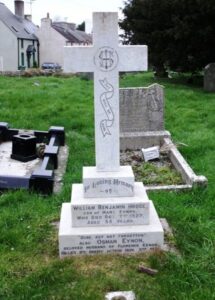
William Thomas McNeill, Able Seaman, D/JX 150512, Royal Navy. William was the son of Samuel John and Mary Elizabeth McNeill, of Angle, and served with the Royal Navy aboard the aircraft carrier HMS Glorious. She was in the Mediterranean at the outbreak of war, and returned to the Home Fleet to support the British forces in Norway, after the German invasion. After successfully ferrying aircraft to Norway, she was returning to Scapa Flow on 8 June 1940 when she was intercepted by the German battleships Scharnhorst and Gneisenau. After a fierce battle, Glorious, along with her escort destroyers, were sunk. William was among more than 1,500 British sailors who died that day. He was 30 years old, and is commemorated on the Plymouth Naval Memorial, Devon.
George Robert Skelton, Corporal, 636765, Royal Air Force. George was the son of John Robert and Florence Mary Skelton, of Angle. He was serving in Lancashire with the Royal Air Force when he married Irene A. Shepherd in 1940, shortly before embarking for the Far East. Irene then moved to Pembroke Dock. George was taken prisoner by the Japanese at some time during their capture of Hong Kong and Singapore. George was taken back to Japan to be used as forced labour, and was detained at Tokyo Number 12 Camp. George became ill with dysentery, and died on 5 December 1942. He was 23 years old, and is buried at Yokohama War Cemetery, Japan.
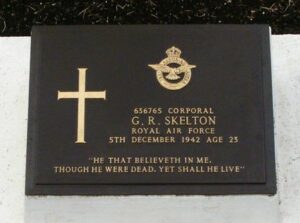
Alfred Charles Wisbey, Chief Officer, Merchant Navy. Alfred was born on 31 December 1901, the son of John and Mary Wisbey of Haslingfield, Cambridgeshire. He entered the Merchant Navy as an apprentice in 1923, and in 1930 married Violet Amy Watkins, of Angle. By the outbreak of war Alfred was serving aboard the London registered M.V. Pacific President. On 2 December 1940 Pacific President was en-route from Leith to New York in Convoy OB-251, when she was torpedoed and sunk by the German submarine U-43, with the loss of 52 lives. Alfred was 38 years old when he died that day, and is commemorated on the Tower Hill Memorial, London. As far as is known, Alfred is not commemorated locally.
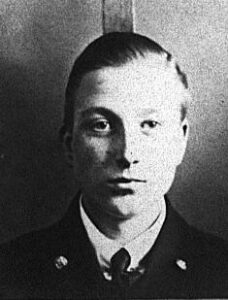
Military Burials at Angle
The Great War, 1914-1918
Fred Symes, Gunner, 17134, Royal Garrison Artillery. Fred was the husband of Annie Mills Symes, of Lower House, West Milton, Melplash, Dorset. He was based at Angle with the 5th Training Company, Royal Garrison Artillery when he died after falling from a cliff while on guard duty on 25 March 1915. A Court of Enquiry showed that Fred had left his post to catch rabbits on the cliff, when a rock gave way beneath him, sending him to his death. Fred was 31 years old, and is buried at Angle (St. Mary) Churchyard.
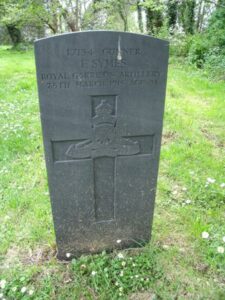
Frederick Tickle, Gunner, 19975, Royal Garrison Artillery. Frederick was the son of Grace Tickle, of Barrow-in-Furness. He was stationed at Angle with the 57th Company, Royal Garrison Artillery, and died there on 26 August 1914 aged 26. Frederick is buried at Angle (St. Mary) Churchyard.
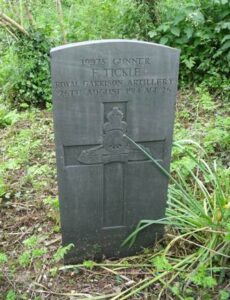
Rudolf Wensburg, Able Seaman, Mercantile Marine. Rudolf was born in Russia, and served in the Mercantile Marine, aboard the SS Lorca, a London registered vessel. Rudolf was one of a small crew of Lorca who drowned when the ship was torpedoed by a German U-Boat on 15 November 1916. He was 28 years old, and his body was later washed ashore near Angle, where he was buried at Angle (St. Mary) Churchyard.
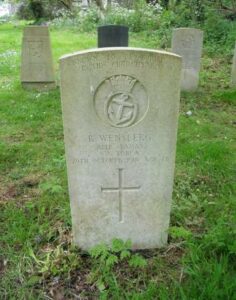
Frederick Witham, Sapper, 87114, Royal Engineers. Frederick was born at Camberwell, Surrey, the son of Elizabeth Witham. He enlisted at Croydon into the Royal Engineers. He was posted to the R.E.T.C. Newark, and was stationed at Angle with the 1/3rd Glamorgan Electric Lighting Company when he died on 6 May 1917. Frederick is buried at Angle (St. Mary) Churchyard.
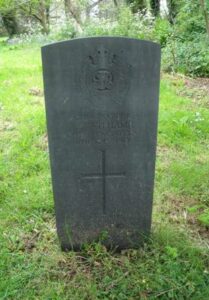
World War Two, 1939-1945
Alexander Craig Aitken, Pilot Officer, J/16586, Royal Canadian Air Force. Alexander was the son of Alexander Drummond Aitken and Margaret Craig Aitken of Toronto, Ontario, Canada. He served as a Pilot with 421 Squadron, Royal Canadian Air Force, which was stationed at RAF Fairwood Common, equipped with the Supermarine Spitfire. Alexander was killed when his SPitfire, EP202, was involved in a mid-air collision near Angle on 24 January 1943. He was 20 years old, and is buried at Angle (St. Mary) Churchyard.
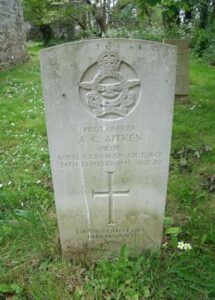
Gilbert Gerard Belec, Flight Sergeant, R/90570, Royal Canadian Air Force. Gilbert was another Canadian, and served as a Navigator/ Bomber with 407 Squadron, Royal Canadian Air Force. No. 407 Coastal Strike Squadron was formed at Thorney Island on 8 May 1941, first training on the Bristol Blenheim. It was one of seven RCAF units to serve with RAF Coastal Command, and from September 1941 to January 1943, the squadron operated as a strike squadron attacking enemy shipping with the Lockheed Hudson. Gilbert was one of four men killed when their Lockheed Hudson crashed on 3 November 1942. He is buried at Angle (St. Mary) Churchyard.
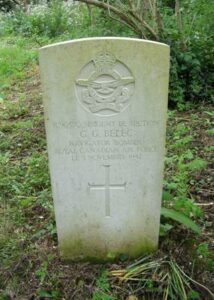
Jan Doucha, Flying Officer, 117613, Royal Air Force Volunteer Reserve. Jan was born in Czechoslovakia, and was one of many Eastern European Pilots who fled to England after the Nazi invasion of their home countries in 1939/40. Jan served with 310 (Czech) Squadron, Royal Air Force Volunteer Reserve. No.310 (Czechoslovak) Squadron was among the first of the foreign volunteer squadrons to be formed during the summer of 1940. In June 1940, many Czechoslovakian pilots who had been fighting with the French decided to escape to the United Kingdom to continue the struggle against the Nazis. These pilots were, after a short period of retraining, and despite many problems of tactics and language, rushed into the Battle of Britain one month after their arrival in the UK, flying the Hawker Hurricane, and later the Supermarine Spitfire. Jan was a veteran of the Battle of Britain, but died at Angle on 7 November 1942. He was 28 years old, and is buried at Angle (St. Mary) Churchyard.
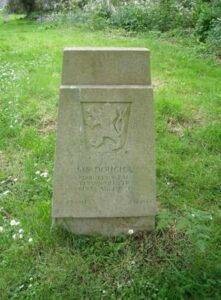
Victor Noel Gaston Fournier, Flying Officer, 169408, Royal Air Force Volunteer Reserve. Victor was the son of Alphonse William and Helen Maude Fournier, and the Husband of Mary Fournier, of Fulham, London. He served as an Air Gunner and appears to have been killed whilst flying in Wellington XIV, Serial HF275 of the CCDU, which burst into flames as a result of a flare which ignited in the bomb bay, causing the Wellington to dive into the sea off Pembrokeshire on 5 August 1944. Victor was 23 years old and is buried at Angle (St. Mary) Churchyard.
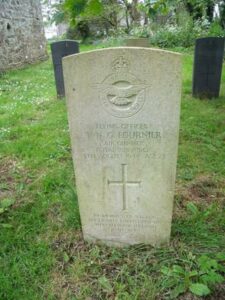
Leslie Eric Letchford Huddleston, Flight Sergeant (Pilot), R/114748, Royal Canadian Air Force. Leslie was another Canadian who flew with 407 Squadron, Royal Canadian Air Force. No. 407 Coastal Strike Squadron was formed at Thorney Island on 8 May 1941, first training on the Bristol Blenheim. It was one of seven RCAF units to serve with RAF Coastal Command, and from September 1941 to January 1943, the squadron operated as a strike squadron attacking enemy shipping with the Lockheed Hudson. Gilbert was one of four men killed when their Lockheed Hudson crashed on 3 November 1942. He is buried at Angle (St. Mary) Churchyard.
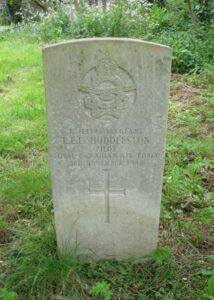
Daniel Brynmor Meredith, Stoker, LT/KX. 99907, Royal Naval Patrol Service. Daniel was born on 4 September, 1907, the son of David and Maggie Meredith, of 3, Station Road, Blaengarw. He had enlisted into the Royal Marines on 14 May 1925 and in 1937 married Lucy Lamplough at Hull. During the war he re-enlisted and was posted to the Royal Naval Patrol Service, aboard HMS Loch Melfort. She was a trawler, which was taken over by the Admiralty in August 1939, and defensively armed. Daniel is recorded to have dived overboard from Loch Melfort on 24 April 1940, and presumably tried to swim ashore before drowning. His body was recovered from the sea and is buried at Angle (St. Mary) Churchyard.
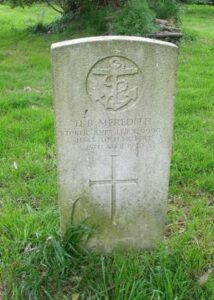
Donald Frederick Page, Flight Sergeant, R/69485, Royal Canadian Air Force. Donald was the son of George E. Page and Annie F. Page, of Cobourg, Ontario, Canada, and served as a Wireless Operator/ Air Gunner with 407 Squadron, Royal Canadian Air Force. No. 407 Coastal Strike Squadron was formed at Thorney Island on 8 May 1941, first training on the Bristol Blenheim. It was one of seven RCAF units to serve with RAF Coastal Command, and from September 1941 to January 1943, the squadron operated as a strike squadron attacking enemy shipping with the Lockheed Hudson. Donald was one of four men killed when their Lockheed Hudson crashed on 3 November 1942. He is buried at Angle (St. Mary) Churchyard. He was 29 years old.
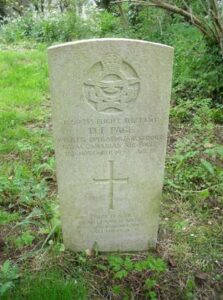
Rodney Lovett Wilkinson, Squadron Leader, 26192, Royal Air Force. Rodney was born in Shrewsbury in 1910, the son of Major Clement Arthur Wilkinson, The King’s Shropshire Light Infantry, and Ruth Violet Esther Wilkinson, of Rotherfield, Sussex. He was educated at Wellington College, and entered the RAF College, Cranwell in January 1929 as a flight cadet. On graduation in December 1930 he joined 3 Squadron at Upavon. He served in the Middle East before joining the Station Flight at Duxford, and was an instructor to Cambridge University Air Squadron. Rodney worked at the Air Ministry before attending a refresher course at 5 OTU Aston Down in June 1940, and after training on Spitfires, he was given command of 266 Squadron at Wittering on 6 July 1940. Rodney shot down a Dornier 17 on 12 August 1940, then a Junkers 88 three days later. On 16 August 1940, Rodney was taking part in a dogfight over Kent when he collided with a Messerschmitt BF109e, and his Spitfire, R6768, crashed and burned out at Eastry Court. Rodney was 30 years old, and is buried in Margate Cemetery, Kent. There is a plaque in his memory within Angle Church.
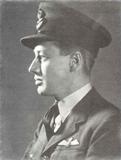
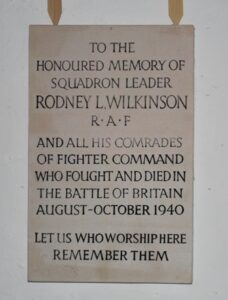
Angle Memorial Hall Plaques
Men Who Served in The Great War, 1914-1919
The plaques on the Memorial Hall have recently been replaced, as the originals were badly weathered. They commemorate the following men, who are listed below in order of Name, Rank, and Regiment. The men who lost their lives during the war are commemorated on this plaque, and also on another memorial inside the Church of St. Mary’s.
George Hughes, Sapper, Royal Engineers.
William Jones, Driver, Welsh Regiment.
John Kenna, Private, Liverpool Regiment.
John Lewis, Gunner, Royal Garrison Artillery.
Thomas Littleford, Private, Welsh Regiment.
Robert Morse, Corporal, Royal Field Artillery.
John Morse, Private, Welsh Regiment.
Joseph Morse, Private, South Wales Borderers.
Joseph Morgan, Private, Australian Imperial Force.
James Morgan, Private, South Wales Borderers.
Stephen Morgan, Driver, Royal Engineers.
Harry Phillips, Private, South Wales Borderers.
Sidney Phillips, Private, Army Service Corps.
Thomas Phillips, Private, Manchester Regiment.
William G Paish, Lance Corporal, Lancers.
Samuel Rees, Private, Hereford Regiment.
Thomas Rees, Trooper, Pembroke Yeomanry.
Lewis Rees, Sergeant, Royal Garrison Artillery.
Howard Rees, Sergeant, Royal Garrison Artillery.
William Richards, Private, Royal Dublin Fusiliers.
Albert Scone, Private, Welsh Regiment.
George Scone, Private, Royal West Riding.
Arthur Sutton, Gunner, Royal Garrison Artillery.
Herbert Sutton, Signaller, Welsh Regiment.
Clive Taylor, Sapper, Royal Engineers.
Douglas Taylor, Gunner, Royal Garrison Artillery.
Sidney Thomas, Private, Welsh Regiment.
Archibald Veal, Trooper, Royal Horse Guards.
Austin Cecil Veal, Private, Welsh Regiment.
William Vaughan, Private, Lancers.
Frederick Wainwright, Gunner, Royal Garrison Artillery.
Frederick Wainwright, Sapper, Royal Engineers.
Thomas Wainwright, Gunner, Royal Garrison Artillery.
Arthur Wainwright, Private, Welsh Regiment.
Henry Watkins, Corporal, Welsh Regiment.
Richard Williams, Sergeant, Welsh Regiment.
James Wilde, Sergeant, Royal Garrison Artillery.
S.S. Hirano Maru Memorial
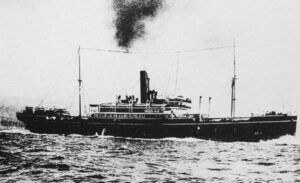
On 4 October 1918 a Japanese steamship, the Hirano Maru, was steaming past the coast of Pembrokeshire, as part of Convoy OE23, which had left Liverpool two days earlier, bound for Yokohama, when she was torpedoed and sunk by the German submarine UB-91, commanded by Wolf Hans Hertwig. The steamship sank with the loss of 292 lives, including a number of children.
Bodies were washed up all along the Pembrokeshire coast in the coming weeks, some of which were identified and buried at Dale, Milford Haven and Angle.
A wooden Memorial was erected in Angle Churchyard to commemorate the ten sailors buried in St. Mary’s Churchyard, Angle following the sinking, and on 4 October 2018 a new granite memorial was erected, in place of the old wooden one, which had long since rotted away.
